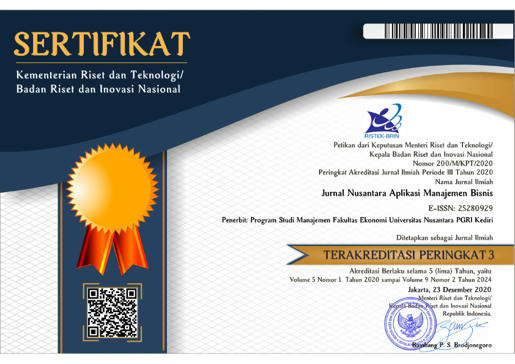Analisis Determinan Kinerja Bisnis Wirausaha Mahasiswa Di Masa Pandemi Covid-19
DOI:
https://doi.org/10.29407/nusamba.v6i2.16214Keywords:
personal characteristics, human capital, social capital, entrepreneurial characteristics, entrepreneurial business performanceAbstract
This study aims to analyze and empirically examine the effect of personal characteristics, human capital, and social capital variables on entrepreneurial business performance variables, with the intervening variable being entrepreneurial characteristics. A sample of 182 respondents, using a questionnaire instrument, the assumption test shows the results of the evaluation of the normality of the data that do not deviate, then the multivariate outliers test has the same degree of freedom of 22, the value of mahalanobis distance ² (0.001;22) = 48.268 so it can be concluded that the model on the data has has no outliers. Residual testing, after the model respecification technique was carried out, it showed that the loading factor of all indicators was > 0.5 and the standardized residual value showed that the value was in the range of ± 2.58 so that it was concluded that the modified model was acceptable. Hypothesis testing, there is a significant influence between the variables of personal characteristics and human capital, on entrepreneurial characteristics. Human capital variables and business characteristics have a significant effect on business performance. But there is no significant effect between the variables (1) social capital on entrepreneurial characteristics, and (2) personal characteristics on business performance. Novelty is a business performance research model with entrepreneurial characteristics as the intervening variable, and the survey was conducted during the economic crisis due to the covid-19 pandemic.
Key words : personal characteristics, human capital, social capital, entrepreneurial characteristics, entrepreneurial business performance
Downloads
References
Abood, N., & Aboyasin, N. A, (2014). Impact of the Entrepreneurial Attributes on Business Performance in a Sample of Jordanian Institutions. International Journal of Professional Management. 9 (1). 1-18. https://www.zuj.edu.jo/wp-content/staffresearch/economic/dr.najem-abood/6.pdf
Aldrich, H. Z., & Zimmer, S. C. C. (1986). Entrepreneurship through social networks. Sexton,DLy.Entrepreneurship_Through_Social_Networks https://www.researchgate.net/publication/291165757_
Antara, (2019). Stafsus : Generasi muda Indonesia terus didorong kembangkan UMKM, https://www.antaranews.com/berita/1195191/stafsus-generasi-muda-indonesia-terus-didorong-kembangkan-umkm, diakses 05 Januari 2021
Ardichvili, A., Cardozo, R., & Ray, S. (2003). A Theory of Entrepreneurial Opportunity Identification and Development. Journal of Business Venturing, Jg.18. S. 105=183. https://doi.org/10.1016/S0883-9026(01)00068-4
Armstrong, M, (2006), Strategic Human Resource Management: A Handbook of Human Resource Management Practice, 10th ed. London: Kogan Page.
Barazandeh, M., Parvizian, K. Khosravi, S. & Alizadeh, M. (2015). Investigating the effect of entrepreneurial competencies on business performance among early stage entrepreneurs Global Entrepreneurship Monitor (GEM 2010 survey data). Journal of Global Entrepreneurship Research. 5 (18), 1-12. https://doi.10.1186/s40497-015-0037-4
Becker, G.S. (1975), Human capital and the personal distribution of income: an analytical approach, in Human Capital: A Theoretical and Empirical Analysis, with Special Reference to Education, 2 edn. New York: National Bureau of Economic Research.
Bouazza, A.B., Ardjouman, D., & Abada, O, (2015), Establishing the Factors Affecting the Growth of Small and Medium-sized Enterprises in Algeria. American International Journal of Social Science,4 (2). 101-115. , www.aijssnet.com/journals/Vol_4_No_2_April_2015/11.pdf,
Camuffo, A., Gerli, F., & Gubitta, P. (2012). Competencies matter: modeling effective entrepreneurship in northeast of Italy small firms. Cross Cultural Management, 19 (1). 48-66. Retrieved from https://doi.10.1108/13527601211195628
Charney, A. & Libecap, G. D. & Center, K.E. (2000). The impact of entrepreneurship education: An evaluation of the Berger entrepreneurship program at the University of Arizona, 1985-1999, Kauffman Research Series. Kansas City, MO: Ewing Marion. Kauffman Foundation. https:// http://doi.org/10.2139/ssrn.1262343
Chell, Elizabeth. (2008). The Entrepreneurial Personality: A Few Ghosts Laid to Rest?, International Small Business Journal, 3 (3). 43-54. https://doi.10.1177/026624268500300303
Clausen, T. H. (2006). Who identifies and exploits entrepreneurial opportunities? Centre for Technology Innovation and Culture. Retrieved from www.ccsr.ac.uk. http://dx.doi.org/10.1016/j.jm.2003.04.002
Coleman, J. S. (1988), Social Capital in the Creation of Human Capital. American Journal of Sociology Supplementary 94. 95-120. http://www.jstor.org/stable/2780243,
Darwin M. & Umam, K, (20200, Indirect effect analysis on structural equation modelling (Comparative study of using Amos and smartPLS software), Nucleus, 1 (2). 50-57, https://doi.org/10.37010/nuc.v1i2.160
Faisol. (2002). Kalau Begitu, Saya Berani Berwirausaha. Jakarta: Bina Rena Pariwara.
Ferdinand, A. 2014, Structural Equation Modeling dalam Penelitian Manajemen:Aplikasi Model-Model Rumit dalam Penelitian untuk Skripsi, Tesis Magister dan Disertasi Doktor, Semarang : Badan Penerbit Universitas Diponegoro.
Ghozali, I, (2017), Model persamaan struktural, konsep dan aplikasi dengan program Amos 24,0, Update Bayesian SEM. Semarang. Badan Penerbit Universitas Dipnegoro : Semarang. https://doi.org/10.1016/j.ando2009.02.007
Ghozali, I, (2021), Partial Least Square: Konsep teknik dan aplikasi menggunakan Program smartPLS 3.2.9 (3rd ed). Semarang. Badan Penerbit Universitas Diponegoro
Gibson, J. l., Ivancevich, J.M.. Donnelly, J.H. & Ivancecivh, R. (2012), Organizational Behavior, structure, processes Fourteenth Editions. New York: McGraw-Hill.
Guiso, L., Sapienza, P. & Zingales, L, (2004), The Role of Social Capital in Financial Development. American Economic Review, 94 (3). 1-56.. https://doi.10.2139/ssrn.209610
Hall, G. (1994). Factors Distinguishing Survivors from Failures Among Small Firms in the UK Construction Sector. Journal of Management Studies, 31 (5), 738-760. https://doi/10.1111/j.1467-6486.1994.tb00637.x
Hair, J.F. Ringle, C.M & Sarstedt, M, (2011), PLS-SEM: indeed a silver bullet. Journal of Marketing Theory and Practice; 19 (2). 139–151. https://doi.org/10.2753/MTP1069-6679190202
House. R, (1999). Weber and the neo-charismatic leadership paradigm: A response to beyer.. Leadership Quarterly. 10(4), 563-574. https://doi.org/10.1016/S1048-9843(99)00032-6
Jamal, W. & Saif, M.I. (2011), Impact of Human Capital Management on Organizational Performance, European Journal of Economics, Finance and Administrative Sciences, 34 (34). 55-69. http://www.eurojournals.com
Jauch, L.R. & Glueck, W.F, (1998), Business Policy and Strategic Management. McGraw Hill, New York.
Jöreskog, K. G., & Sörbom, D. (1993). LISREL 8: Structural equation modeling with the SIMPLIS command language. Scientific Software International; Lawrence Erlbaum Associates, Inc. https://psycnet.apa.org/record/1993-97878-000
Kuratko, D. F., Ireland, R. D., & Hornsby, J. S, (2004), Corporate entrepreneurship behaviour among managers: A review of theory, research, and practice. Advances in Entrepreneurship, Firm Emergence and Growth, 7(04), 7-46. https://doi. 10.1016/S1074-7540(04)07002-3
Latan, H, (2013), Model Persamaan Struktural Teori dan Implementasi AMOS 21.0. Bandung: Alfabeta
Lembaga Ilmu Pengetahuan Indonesia, (2020), Survai kinerja UMKM dimasa Pandemi Covid-19, http://lipi.go.id/berita/survei-kinerja-umkm-di-masa-pandemi-covid19/22071, diakses 02-11-2020
Li, X., and Jia, Y, (2015), Characteristics Influence for Entrepreneurship Behavior Ability. In International Conference on Education, Management, Commerce and Society (EMCS-15), htpps: doi.10.2991/emcs-15.2015.123
Liang, K., & Dunn, J. (2010). Entrepreneurial Characteristics, Optimism, Pessimism, and Realism – Correlation or Collision? Journal of Business and Entrepreneurship, 22 (1), 1-21 www.researchgate.net/publication/308943051
Lumpkin, G. T., & Dess, G. G, (1996), Clarifying the entrepreneurial orientation construct and linking it to performance. Academy of Management Journal, 21(1), 135-172.. https://doi.org/10.2307/258632
Mateju, P, (2002), Social Capital: Problemsof its Concctlalization and Measuremellt in Transforrning Societies. Paper Prepared on thc OECE-ONS. Conferencc on Social Capital Mcasurement.London, September 26-27.
Mayo, Andrew . (2000), The Role of Employee Development in The Growth of Intellectual Capital, Personal Review, 29 (4). 521-533. https: doi.10.1108/00483480010296311.
Mathis, R. L., Jackson, J.H. & Sadeli, J. (2006), Human Resource Management, Alih Bahasa Salemba Empat Jakarta
McDowell, W. C., Peake, W. O., Coder, L. & Harris, M. L. (2018), Building small firm performance through intellectual capital development: Exploring innovation as the “black box”, Journal of Business Research. 88. July. 321-327. htpps: doi.10.1016/j.jbusres.2018.01.025.
Meredith, Geoffrey G, (2006), Kewirausahaan Teori dan Praktek. PT Pustaka Binaman Pressindo. Jakarta Pusat
Mutegi, H. K., Njeru, P. W., & Ongesa, N. T, (2015), Financial Literacy and Its Impact on Loan Repayment by Small and Medium Enterprenuers: An Analysis of the Effect of Book Keeping Skills from Equity Group Foundation’s Financial Literacy Training Program on Enterpreneurs’ Loan Repayment Performance. International Journal of Economics Commerce andManagement, III (3). 1-28. http://ijecm.co.uk/wp-content/uploads/2015/03/3355.pdf
Nurwulandari, A & Darwin, M, (2020), Heywood case data statistik: menggunakan teknik respifikasi model, Nucleus. 1 (2). 74-84. https://doi.org/10.37010/nuc.v1i2.173
Robbins, S. P. &. Judge, T.A. (2014), Perilaku Organisasi. Edisi 14. Jakarta : Salemba Empat.
Roblesa, L., & M. Z. Rodrigueza. (2015). Key Competencies for Entrepreneurship. Procedia Economics and Finance. 23, 828-832. www.elsevier.com/locate/proceeding.. https: doi: 10.1016/S2212-5671(15)00389-5
Santoso, Yusuf Imam, (2020), Menghitung dampak Covid19 terhadap dunia usaha hingga UMKM, kontan.co.id, https://nasional.kontan.co.id/news/menghitungdampak-covid-19-terhadap-dunia-usaha-hinggaumkm?page=all. diakses 22 April 2020
Sari, N. M. W., Suwarsinah, H. K., & Baga, L. M, (2016), Pengaruh Karakteristik Kewirausahaan terhadap Kinerja Usaha Mikro, Kecil dan Menengah(UMKM) Gula Aren di Kabupaten Lombok Barat. Jurnal Penyuluhan, 12 (1), 51-60. https://doi.org/10.25015/penyuluhan.v12i1.11320
Schermerhon. (2005). Management, 8th edition. John Wiley & Sons, Inc, USA
semarang.bisnis.com, 2020, Survai BI : Kinerja UMKM kian memburuk, dari https://semarang.bisnis.com/read/20201009/536/1303031/survei-bi-kinerja-umkm-kian-memburuk, diakses 02-11-2020
Shane, S., Locke, E.A. & Collins, C.T. (2003). Entrepreneurial Motivation, Human Resources Management Review. 13 (2), 257-279. https : doi.10.1016/S1053-4822(03)00017-2.
Sobel, M. E, (1982), Asymptotic confidence intervals for indirect effect in structural equation models. In S. Leinhardt (Ed.), Sociological Methodology. 13 (2), 257-279. https://doi.org/10.2307/270723
Stam W. & Elfring T. (2008). Entrepreneurial orientation and new venture performance: the moderating role of intra and extraindustry social capital. Academic of Management journal 51(1). 97-111. https: doi/abs/10.5465/amj.2008.30744031
Totanan, C., (2004). Peranan Intellectual Capital dalam Penciptaan Nilai untuk Keunggulan Bersaing, Usahawan. Tahun XXXIII. 1 (1). 27-31
Thoha. Miftah. (2007). Kepemimpinan Dalam Manajemen. Jakarta: PT. Raja Grafindo
Vargas, H.C, Montoya, N.P. & Escobedo, R. F. (2019), Effect of entrepreneurial orientation in business performance: the mediating role of customer satisfaction-a formative- reflective model analysis, SAGE open, 9.(2), 1-14. https://doi.org/10.1177/2158244019859088.
Walker, O.C. & Ruekert, R.W. (1987). Marketing’s Role in the Implementation of Business Strategies: a Critical Review and Conceptual Framework. Journal of Marketing, nal of Marketing. 51 ( 3 ), 15-33. https://doi.org/10.2307/1251645
Wang & Chang, (2005), Intellectual Capital and Performance in Causal Models Evidence from the Information Technology Industry in Taiwan, Journal of Intellectual Capital. 6 (2). 222-236. 222-236. https://doi.org/10.1108/14691930510592816
Wang, C. L, (2008), Entrepreneurial orientation, learning orientation, and firm performance. Entrepreneurship Theory and Practice, Sage Journal, 44(0), 1-26. https://doi.org/10.1111%2Fj.1540-6520.2008.00246.x
Wickham PA. (2004). Strategic Entrepreneurship 3th Ed. Essex (GB): Pearson Education Limited.
Woolcock, M & Narayan, D, (2000), Social Capital: Implications for Development Theory, Research, and Policy. The World Bank Research Observer 15 (2), 225-249. https://doi.org/10.1093/wbro/15.2.225
Downloads
Published
Issue
Section
License
Authors who publish with this journal agree to the following terms:
- Copyright on any article is retained by the author(s).
- The author grants the journal, the right of first publication with the work simultaneously licensed under a Creative Commons Attribution License that allows others to share the work with an acknowledgment of the work’s authorship and initial publication in this journal.
- Authors are able to enter into separate, additional contractual arrangements for the non-exclusive distribution of the journal’s published version of the work (e.g., post it to an institutional repository or publish it in a book), with an acknowledgment of its initial publication in this journal.
- Authors are permitted and encouraged to post their work online (e.g., in institutional repositories or on their website) prior to and during the submission process, as it can lead to productive exchanges, as well as earlier and greater citation of published work.
- The article and any associated published material is distributed under the Creative Commons Attribution-ShareAlike 4.0 International License












